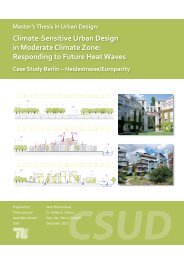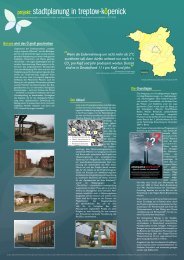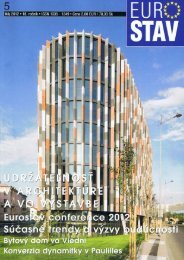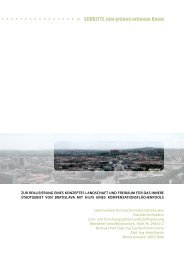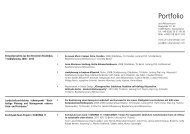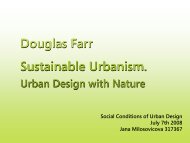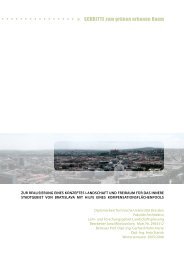Bausteine - Referate - Jana Milosovicova - Urban Design English
Bausteine - Referate - Jana Milosovicova - Urban Design English
Bausteine - Referate - Jana Milosovicova - Urban Design English
Erfolgreiche ePaper selbst erstellen
Machen Sie aus Ihren PDF Publikationen ein blätterbares Flipbook mit unserer einzigartigen Google optimierten e-Paper Software.
scores to locations where a new plan would<br />
have a positive effect on fresh air movement<br />
and lower scores as the movement of fresh air<br />
decreases.<br />
Energy<br />
there are no negative effects and a bad score<br />
corresponding to the increase in any problems.<br />
The Assessment Matrix addresses traffic noise,<br />
giving a higher score if there are no negative<br />
effects and a lower score if traffic noise turns<br />
into a major disturbance.<br />
LEED-ND offers two energy credits, one for<br />
providing on-site energy generation for at least<br />
five percent of the project’s electrical and/or<br />
thermal load, and the other for providing the<br />
same amount of energy using renewable sources<br />
such as solar, wind, geothermal, hydroelectric<br />
and biomass. The Assessment Matrix only considers<br />
renewable energy, providing good scores<br />
to plan areas that are suitable for renewable<br />
energy and poor scores to locations where<br />
renewable energy options are limited or not<br />
possible.<br />
Recycling<br />
LEED-ND also offers credits for recycling and<br />
reusing during the construction process and<br />
the final use. This includes one credit for the<br />
use of recycled content in asphalt and concrete<br />
infrastructure such as roads or parking areas<br />
and another for recycling or salvaging at least 50<br />
percent of construction waste. The credit that<br />
focuses on the end user is given for including<br />
a hazardous waste drop-off site, a recycling or<br />
reuse station and a compost station or locating<br />
in a city that offers those services.<br />
7. Pollution<br />
LEED-ND and the Assessment Matrix consider<br />
pollution problems, although they focus<br />
on different types of issues. LEED-ND offers a<br />
light pollution credit to encourage dark night<br />
skies, which can be met by lighting areas not<br />
exceeding 50 to 80 percent of the ASHRAE<br />
standards (an independent certifying organization).<br />
The Assessment Matrix also considers light<br />
along with other types of pollutants such as<br />
odors or poor air, providing a good score when<br />
Iv. Conclusions<br />
Through this analysis, it is clear that there are<br />
indeed universal goals of sustainable neighborhoods.<br />
Yet there are some issues are different,<br />
mostly problems unique to the U.S. However,<br />
the<br />
Universal Goals<br />
Considering LEED-ND and the Assessment Matrix<br />
were developed separately, the amount of<br />
overlap between both systems is notable. One<br />
area of overlap is related to “Good <strong>Urban</strong>ism”<br />
– based on location, transportation and mixedland<br />
use. Good <strong>Urban</strong>ism criteria include:<br />
• an urban location on previously developed land;<br />
• good transit proximity and connections that go to<br />
common destinations;<br />
• a bicycle network that goes to common destinations;<br />
• a variety of common destinations: daily needs, cultural,<br />
social, recreational;<br />
• density and walkable places enjoyable to users.<br />
The other main area is the “Protection of Nature,”<br />
which considers the impact of human<br />
development on the natural environment. Protection<br />
of Nature criteria include:<br />
• the absorption of rainwater into the ground;<br />
• the protection of water bodies, habitat, flora and<br />
fauna;<br />
• microclimate air quality and temperature;<br />
• green buildings that reduce resource use (during<br />
construction and operation);<br />
• renewable energy.<br />
Together, these goals begin to form the basis<br />
109



